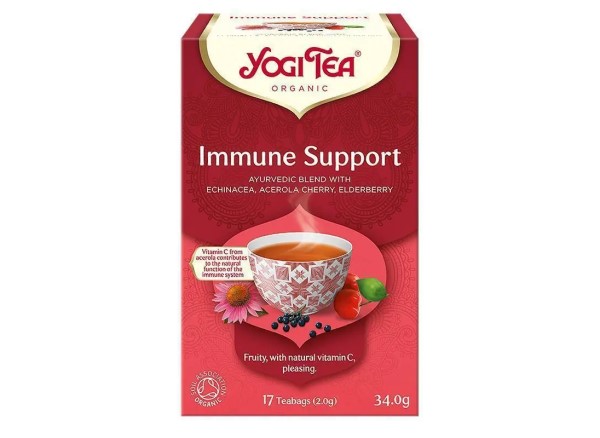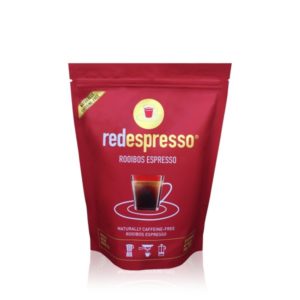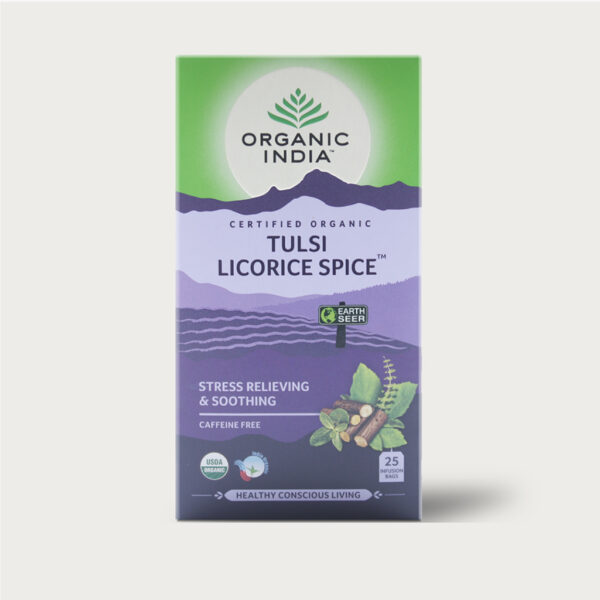Yogi Tea – Organic Immune Support 17 Teabags
R100.06
In the ups and downs of the seasons, our immune system sometimes also needs some support.
Out of stock
Description
In addition to a varied and balanced diet as part of a healthy lifestyle, this is just the right time to enjoy a hot cup of YOGI TEA® Immune Support. The delicately tangy taste of echinacea blends with fruity elderberry and aromatic basil. The natural vitamin C from the acerola cherry provides natural support for our body’s defences. The subtle message of this tea is: “Well protected.”
Ingredients
Echinacea*, rose hips*, dried acerola juice*, basil*, cinnamon*, ginger*, cardamom*, elderberries*, black pepper*, moringa*, hibiscus*, cocoa shells*, liquorice*, fennel*
*Certified Organic
Brewing Suggestions
Pour 200 ml of freshly boiled water over the teabag. Allow to infuse for 5 minutes.
More about Yogi Tea Immune Support
Echinacea
Echinacea is a plant that grows wild in North America and has long been valued by Native Americans. It attains a height of 90 cm and has purple leaves. Echinacea tastes slightly sweetish and tart-spicy.
Acerola
Bright red: This is the acerola cherry. The finely tart and fruity-fresh tasting fruit primarily thrives in South America and Jamaica – in ravines, on riverbanks and mountain slopes or at the edges of streets. Its fruit pulp is especially juicy and has a fluid content of up to 80%.
Rose hip
A member of the rose family, the rosehip has bright red fruit that contains many little nutlets. It thrives in the wild throughout all of Europe and Asia, preferable in a site with direct sunshine. Depending on when they are harvested, the taste of rosehips ranges from sourish-tart to slightly sweetish
Elderberries
Elderberries were already found in the human diet more than 6,000 years ago. When cooked, the black shiny fruit is excellently suited for desserts and juices. This naturally also applies to tea. They taste tartly sweet and fruity.
Basil
This “royal plant”, as the Ancient Greeks called basil, came to northern Europe in the 12th century. It has a wonderfully spicy aroma, which is ideally featured in both Mediterranean cuisine and freshly brewed tea.
Cinnamon
Cinnamon is among the most expensive spices in the world and was supposedly already used as a spice in China in 3,000 B.C. Cinnamon is extracted from the bark of the South-Asian cinnamon tree. It has an aromatic-sweetish taste and contains valuable essential oils.
Ginger
Whether in the Christmas biscuits, as a curry mixture or in lemonade: The bulbous ginger is among the best-known spice plants in the world. For thousands of years, it has been cultivated in the tropical heat of eastern Asia. It gives many of our YOGI TEA®s a fruity-hot and aromatically spicy taste.
Cardamom
Cardamom has been one of the most popular spices for thousands of years throughout the entire Asian and Arabian area. Its subtle, sweetish-spicy aroma predestines cardamom for use in many different foods ranging from sharp curries to spicy Christmas biscuits.
Moringa
Originally from the Himalayas, the moringa tree is a fast-grower that already reaches the height of 8 metres during the first year. Based on its subtle spicy and slightly pungent taste, it is also known as the “horseradish tree”.
Black pepper
Also called the “king of spices,” black pepper is one of the world’s most important spices in addition to salt. It originally came from the Indian Malabar Coast and tastes intensive-spicy, ranging from slightly spicy to quite spicy
Hibiscus
Hibiscus, which is sometimes given other names such as the rose mallow, originally came from the tropics. In addition to its beauty, it is now also valued for its pleasantly fruity, sweet-sourish tasting flowers. Thanks to its conspicuously large flowers, it can now be found in many European gardens.
Cocoa shells
The cocoa tree, which originally came from the Latin American rainforest, is primarily famous for its beans – the basic raw material of chocolate. But the shells of the cocoa bean fruit are also bursting with a sweetish-soft aroma and contain much fewer calories.
Fennel
Fennel belongs to the umbellifer family and has been popular for thousands of years around the globe due to its intensive aroma. It originally came from the Mediterranean region. Its sweetish-spicy taste is slightly reminiscent of anise.
Disclaimer
The contents of the Knysna Health website shall not be regarded as medical advice, or a basis from which to make medical decisions. The use of information found on this site is completely your responsibility and at your own risk. Our recommendation is that if you have health concerns that you feel unsure about how to deal with, that you contact your trusted health professional for personalized advice.




